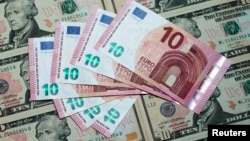In a high-stakes juncture for the global economy, the central banks of Europe and the United States are set to take opposing actions in December: the European Central Bank to cut rates, the Federal Reserve to raise them.
For the struggling eurozone, it can't happen soon enough.
The divergence between two of the biggest forces in the world economy has the effect of weakening the euro against the dollar, providing a valuable boost to economic growth in Europe at a time of mounting uncertainty. For the more solid U.S. economy, it is creating an unwelcome headwind.
The euro has fallen against the dollar since the ECB signaled last month that on Dec. 3 it would further trim interest rates or expand its monetary stimulus, both of which tend to weigh on a currency. At the same time, the Federal Reserve has been pushing the dollar higher by indicating it's likely to raise rates on Dec. 16 for the first time in nearly a decade.
That "suggests the euro should be one of the weakest major currencies over time,'' says Nick Bennenbroek, head of currency strategy at Wells Fargo Securities.
The euro's drop is important because it has become a key driver of the moderate upswing in the economy of the 19-country eurozone.
German auto industry
In particular, it strengthens Germany, the largest member of the currency union. There, the economy relies on exports of autos by the likes of Daimler and BMW as well as industrial and factory equipment made by smaller companies.
In a survey of 225 financial sector professionals published Tuesday, the ZEW research institute found that the lower euro had increased optimism over the future of the German economy.
The currency's decline helps the region offset the slowdown in global trade with developing economies, particularly China. It doesn't just benefit Germany: the country's industrial companies spread the wealth by buying from suppliers in other European countries.
And as companies do better and unemployment drops gradually, consumers are spending more.
A weaker euro also means cheaper travel and shopping for tourists, particularly Americans and Chinese, whose own currency is linked to the dollar and tend to splurge on luxury goods in Europe.
Andreas Rees, chief German economist at UniCredit Research, says a 10 percent decline in the euro — weighted against major trading partners, not just the U.S. — can boost GDP by 0.6-0.7 percent over 12 to 18 months. The trade-weighted euro has fallen 9 percent since shortly before the ECB unveiled its trillion-euro stimulus program in January. It has fallen 4 percent since Oct. 22, when ECB President Mario Draghi indicated more rate cuts were on the way.
Boost for eurozone
That would be a significant bonus for the eurozone economy, which grew by a meager 0.3 percent in the third quarter compared with the quarter before. Unemployment is only slowly edging down from a high 10.8 percent. The inflation rate of 0.1 percent is so low it has awakened fears of long-term stagnation.
While the ECB says it does not target a specific rate for the euro, it's clear that it welcomes the currency's drop.
Draghi pushed the euro sharply lower in October, when he said the bank might consider deeper rate cuts at its December meeting, as well as a boost to its 1.1 trillion euro ($1.2 trillion) monetary stimulus through bond purchases that is already weighing on the euro's exchange rate.
He mentioned the bank could cut the rate charged banks to stash money at the ECB's super-safe deposit facility from a negative 0.2 percent. Some analysts think the ECB might expand its bond-buying stimulus program or even cut its chief benchmark, the rate at which it loans to banks, from a record low 0.05 percent to zero.
Draghi's comments helped bring the euro down to around $1.07 from $1.09 before his comments. That's a steep fall from around $1.39 in the first quarter of 2014.
Some think the euro's drop has run its course and that Draghi will have to announce something big to keep a lid on it.
That's also true because the Fed is aware that when it comes to the euro-dollar exchange rate, the eurozone's gains are the U.S.'s loss.
Impact on US exports
Just as a weaker euro helps European exporters, a higher dollar makes life harder for U.S. companies with operations in Europe, as earnings made in the 19-country currency bloc shrink when translated into dollars.
With an eye on that dynamic, the Fed may indicate it will only raise rates very gradually to limit the dollar's rise and the euro's drop.
"There is this sense that the downtrend in euro-dollar is already getting a little tired,'' said Jane Foley, senior currency strategist at Rabobank International in London. That puts pressure on Draghi.
"I think he might have to surprise us in order to really push the euro beyond this sort of stalling block at the moment.''









